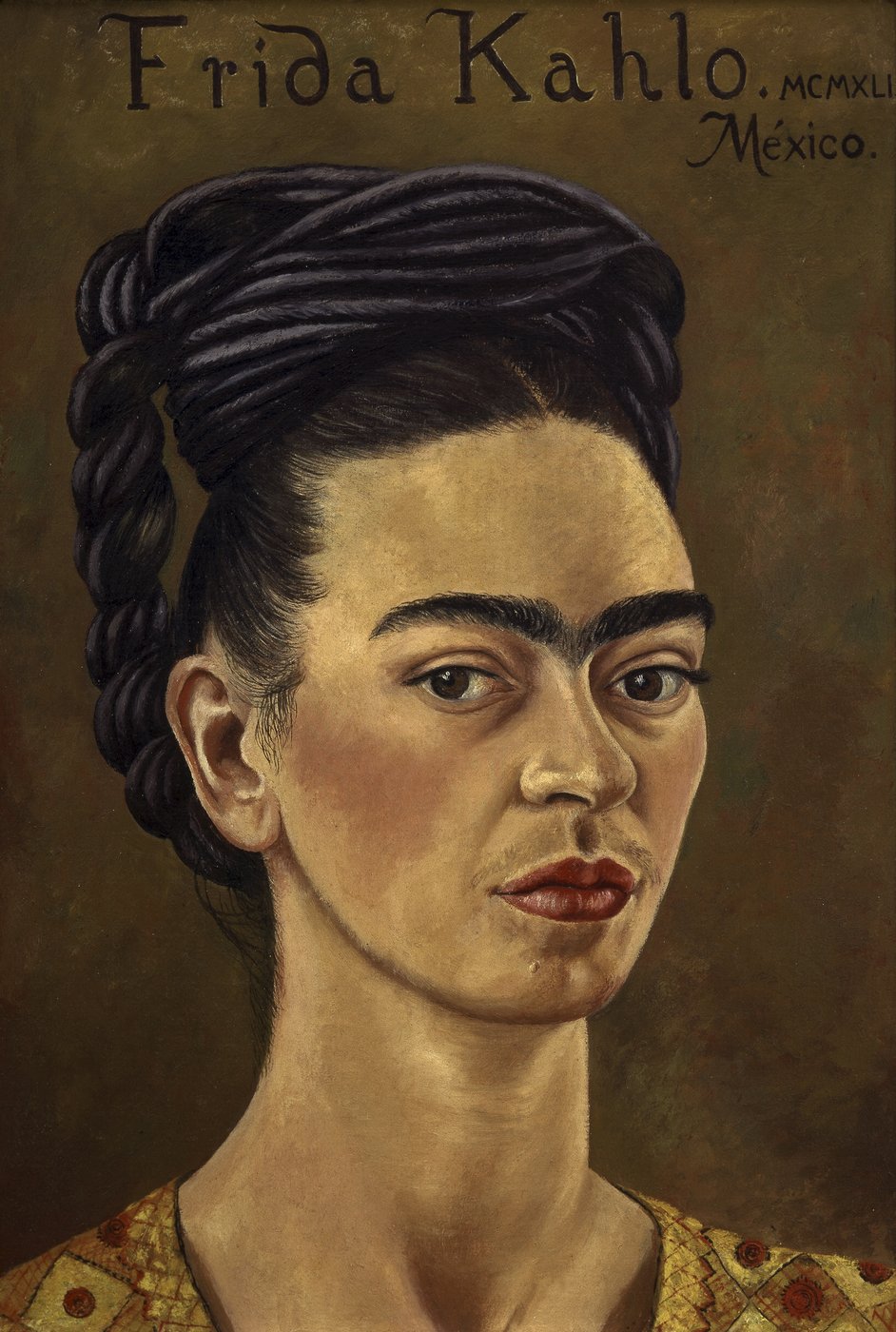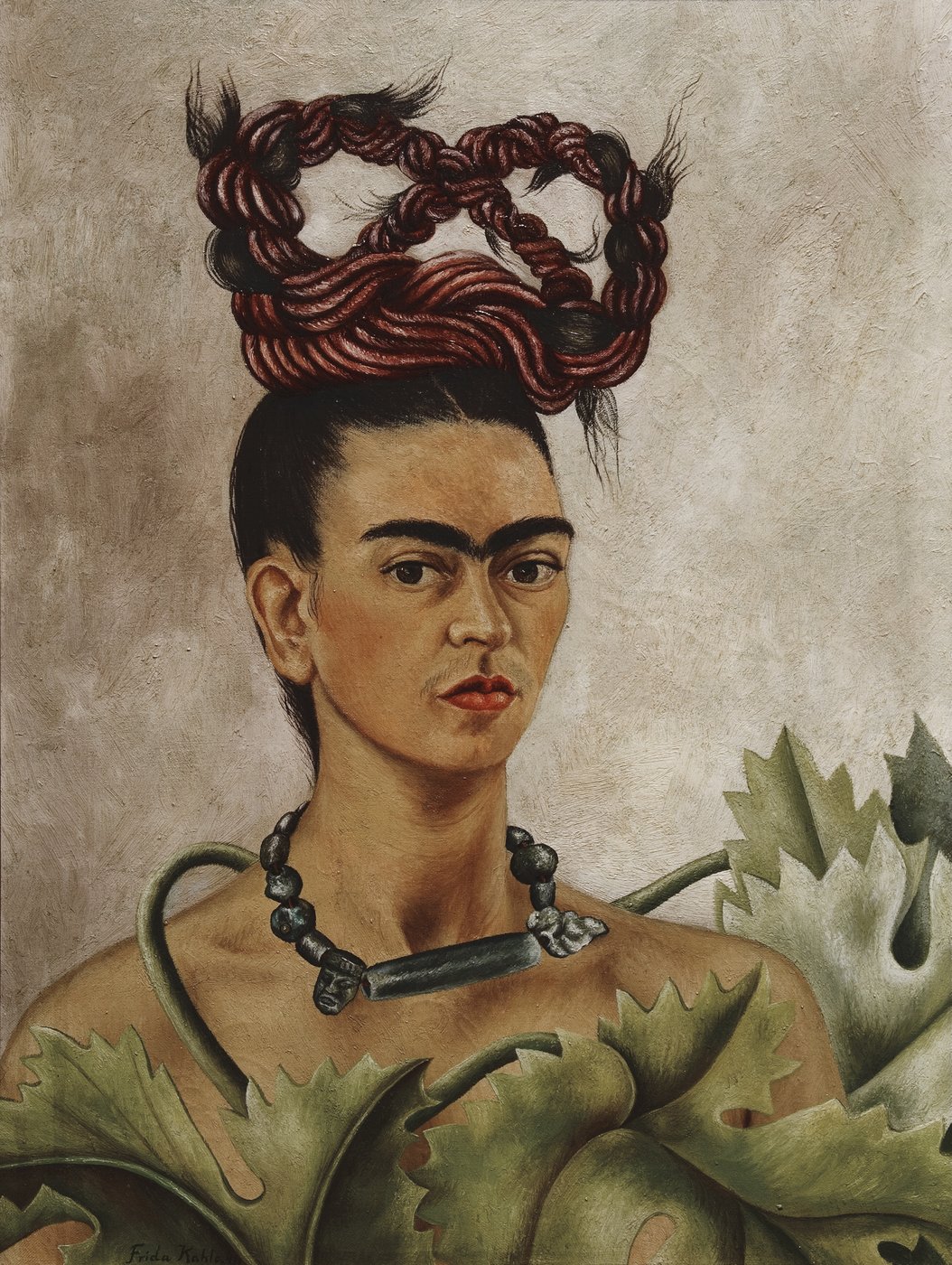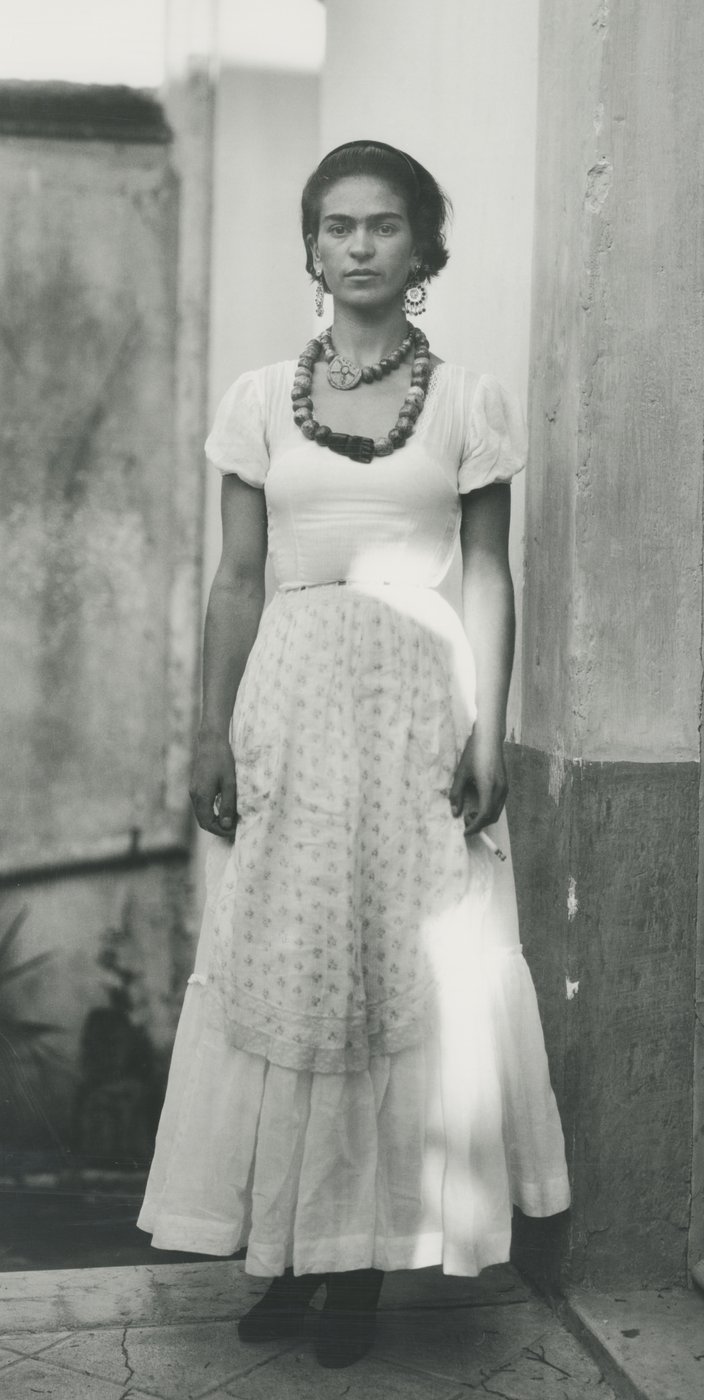Menu
Frida Kahlo and Diego Rivera
from the Jacques and Natasha Gelman Collection 25 Jun – 23 Oct 2016
Self and identity

Lucienne Bloch, 'Frida at the Barbizon Plaza Hotel', 1933
‘The only artist in the history of art who tore open her chest and heart to reveal the biological truth of her feelings.’ – Diego Rivera
Out of the less than 200 paintings Frida Kahlo made in her short life, about a third were self-portraits.
Frida’s powerful autobiographical works have made her one of the most influential artists of her century – and one of history’s most recognisable faces.
Her self-portraits, while shockingly revealing, also expose her an exploratory approach to self-presentation and identity; be it as a woman, as a revolutionary, a disabled person, a wife, a lover, a Mexican.
Enlarge
Frida Kahlo, 'Self-portrait with necklace', 1933
For much of her life, Frida was known as ‘Diego Rivera’s wife’. Initially, her fame was overshadowed by the towering figure of Mexican painting who had married a girl 20 years his junior.
Though compared to Diego, Frida was a relatively untrained artist; by the time of her death she was well on the way to becoming a national treasure in Mexico.
By the 1980s, when the work of reclaiming women artists was being done, she had become a feminist hero.
Today, while the celebrated couple both grace Mexico’s 500 peso note, it is Frida who is the global icon.
Enlarge
Frida Kahlo, 'Self-portrait with red and gold dress', 1941
Bertram Wolfe, friend of the Riveras, called Frida’s paintings ‘so intimate … we could easily reconstruct her life and personality from them.’ She seems to disclose her secrets to us, painting her tears, her loves, her miscarriages and her broken body.
And yet, she is a contradiction: for all that intimacy, it’s hard to find the ‘real’ Frida.
Frida favoured a direct unsmiling stare and a three-quarter pose for most of her self-portraits, and took up the same pose in the many photographs taken of her.
Her look has been called defiant, and also mask-like; Diego nicknamed her ‘la gran ocultadora’, ‘the great concealer’.
Enlarge
Frida Kahlo, 'Self-portrait with braid', 1941
Frida played with notions of identity throughout her life.
Though born in 1907, she later claimed 1910, the year of the Mexican Revolution, as her birth year.
Some say this was just vanity, but it was also a statement of identification: she was a ‘child of the revolution’.
Frida also mined different aspects of her ancestry to suit her. Just as her father Wilhelm Kahlo had changed his name to Guillermo, so Frida changed her German given name Frieda to her famous Latinised version in the 1930s.
She even made up a Jewish ancestry, perhaps to dissociate herself from Nazism during the war, perhaps to identify as an outsider.
Enlarge
Lola Alvarez Bravo, 'Frida Kahlo', c1940s
Frida had already been marked physically by a bout of polio at the age of 6. This left her with a shorter, misshapen and troublesome right leg – as well as a legacy of childhood teasing.
In 1925, when she was only 18, Frida suffered the terrible accident that would affect her health throughout her life.
While coming home from school with her boyfriend, their bus was hit by a streetcar. Frida was seriously hurt: her injuries included a broken back, ribs, collarbone, left shoulder and right leg.
A metal handrail pierced her abdomen and womb, smashing through her pelvis and exiting on the other side.
Enlarge
Lola Alvarez Bravo, 'Frida Kahlo', 1943
While recovering in hospital over many months, Frida started to paint.
Her parents set her up an easel and – as she was the subject to which she had the greatest access – rigged up a mirror above her hospital bed. As she would later say:
‘I paint self-portraits because I am so often alone, because I am the person I know best.’
Within a year of her accident, Frida had painted her first mature painting, Self-Portrait in a Velvet Dress.
Painting became a way to communicate her pain – both physical and emotional – as well as her joy. And her ‘self’ was to become the subject that dominated her artistic output.
Enlarge
Bernard Silberstein, 'Frida with flowers in her hair', c1940
Frida gave many of her early self-portraits away as gifts, mementos to connect with others.
After her accident, she gave a portrait to her lifelong friend Alejandro, telling him: ‘I implore you to hang it in a low place where you can see it as if you were looking at me.’
As the daughter and granddaughter of photographers who would herself become an icon, Frida understood instinctively the power of her own image.
‘I knew the battlefield of suffering was reflected in my eyes. Ever since then, I started looking straight into the lens, without winking, without smiling, determined to prove I would be a good warrior until the end.’
Enlarge
Guillermo Davila, 'Frida', 1929
Frida was a spirited and truly modern young woman who loved playing around with her appearance. Even before her accident, she was exploring the image of ‘la chica moderna’, the Mexican version of the 1920s flapper.
Frida was also interested in fluid gender identities. In early family photographs taken by her father, she can be seen cross-dressing in men’s clothes:
‘I used to dress like a boy, with my hair cut short, pants, boots, and leather jacket.’
Later, she also refused to pin down her own sexual identity, having affairs with women as well as men throughout her life.
Enlarge
Frida Kahlo, 'Diego on my mind (Self-portrait as Tehuana)', 1943
The hybrid Indian-Spanish origins of her mother became an important source of inspiration to Frida.
Once Diego and Frida were married, she took to wearing Tehuana dresses from the southeast Mexican state of Oaxaca, home to mother’s family.
Oaxaca was a rare matriarchal society within a largely patriarchal country. To Frida, its costume was a symbol of female power.
She also favoured this indigenous style of dress because the long skirts and blouses helped cover her misshapen leg and the corsets she was forced to wear.
But most importantly, she wore her magnificent dresses because both she and Diego recognised them as emblems of national pride.
Enlarge
Lola Alvarez Bravo, 'Frida in bedroom', 1945
Indigenous dress formed a big part of Frida’s persona, together with her elaborately garlanded hair and jewellery. By the early 1930s when the couple was living in the USA, Frida had truly polished that persona.
Referred to in several articles, including in Vanity Fair, Time and Vogue, as ‘Diego Rivera’s beautiful young wife’, Frida’s exotic looks made quite an impact in America.
Her friend the photographer Edward Weston wrote that in San Francisco, ‘people stop in their tracks to look in wonder’ at the colourful character Frida presented to the world.
She loved every minute of it.
Enlarge
Juan Guzmán, 'Frida with two birds', c1940s
Later in the 1930s, Frida was included in a photo essay on modern Mexican women in American Vogue (October 1937), with images by Toni Frissell.
A year later Frida’s hands, covered in silver rings, featured on the cover of French Vogue and, in 1939, when still in Paris for the surrealist exhibition ‘Mexique’, she again became the centre of attention in her Tehuana costumes.
Designer Elsa Schiaparelli, who created surrealist costumes as well as haute couture clothing, even spoke about wanting to create a dress, ‘La Robe Madame Rivera’, based on Frida’s exotic look.
Enlarge
Bernard Silberstein, 'Frida painting 'The Wounded Table', Coyoacán', 1940
Frida’s intimate paintings didn’t fit into any one artistic style, certainly not the grandly nationalistic Mexican modernism led by Diego.
While Diego focussed on painting the serious matters of the wider world, Frida chronicled the state of their marriage, their affairs, and her physical and emotional pain in her paintings.
Surrealism helped create a framework for her work, but it was a label she rejected:
‘They thought I was a Surrealist, but I wasn’t. I never painted dreams. I painted my own reality.’
Over time however, the ‘reality’ of her intensely subjective images revealed itself to be a kind of politics of the personal, and a new model in self-portraiture.
Enlarge
